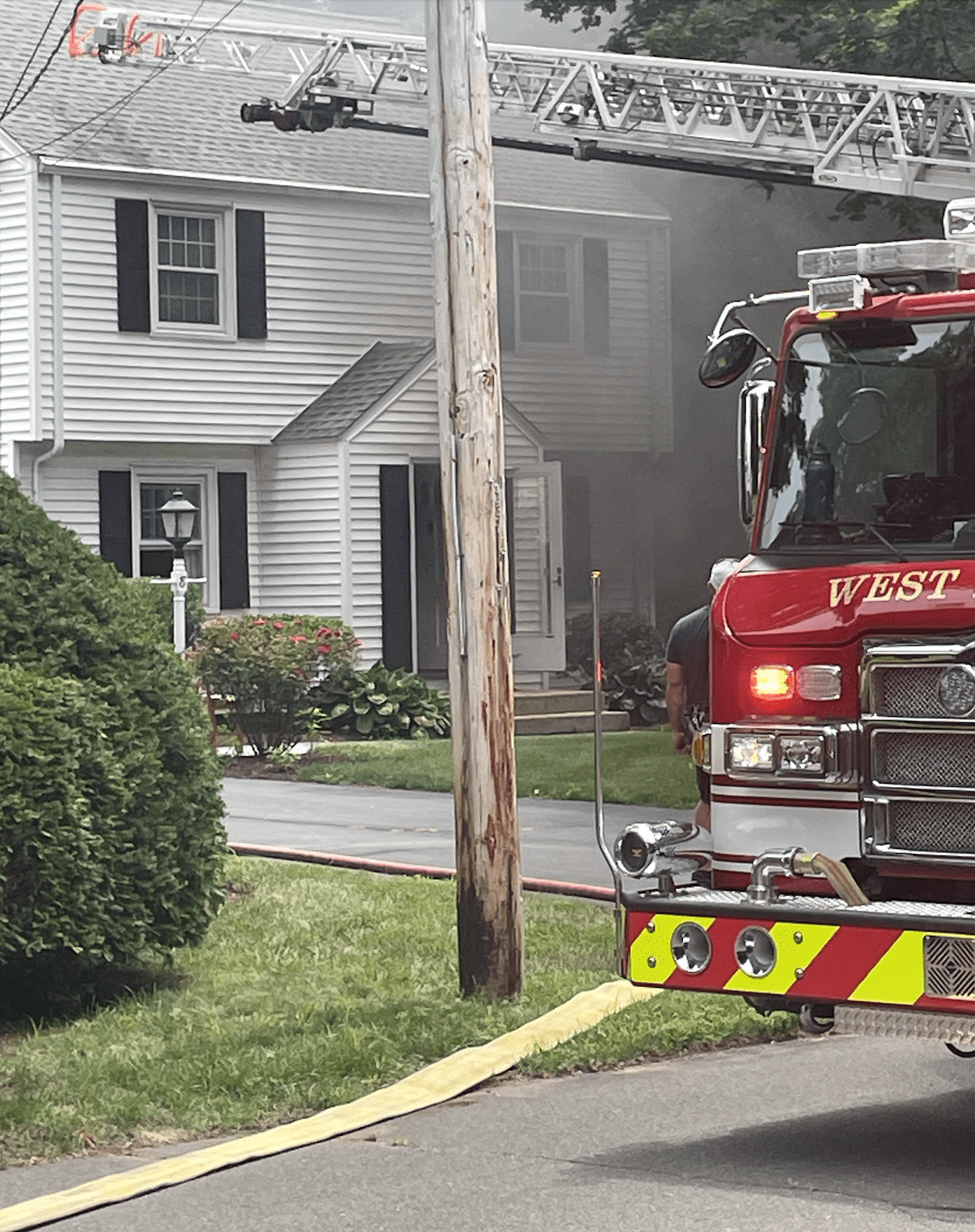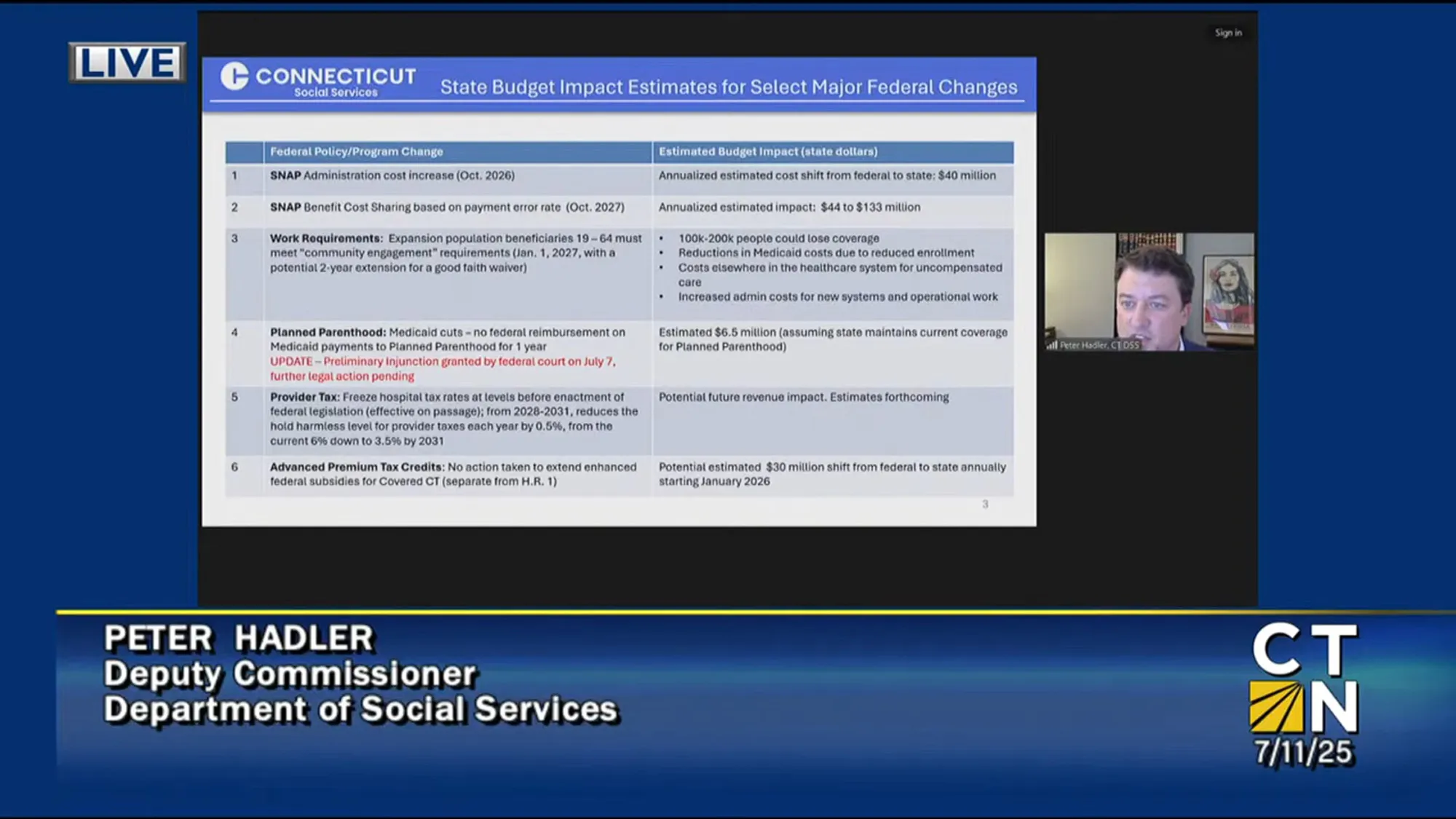House Democrats Counter with Trucks-Only Tolls

Audio By Carbonatix

House Majority Leader Matt Ritter. Photo credit: Keith M. Phaneuf, CTMirror.org
Gov. Ned Lamont praised House Democrats for offering a proposal that shares two of his goals.
By Mark Pazniokas and Keith M. Phaneuf, CTMirror.org
The House Democratic majority offered a transportation financing plan Tuesday that recycles a campaign proposal made and abandoned by Gov. Ned Lamont: Trucks-only tolls to be charged at a dozen bridges on interstate highways in Connecticut.
The concept was quickly welcomed by Senate President Pro Tem Martin M. Looney, D-New Haven, whose unyielding opposition effectively killed Lamont’s broader proposal of charging tolls on all motor vehicles at 14 tolling gantries.
“Some members of our caucus would favor that,” Looney said, saying it keeps faith with a campaign promise Lamont made last year. “The original plan he ran on – the trucks-only – is the only voter-tested proposal that is out there.”
Lamont praised the House Democrats for reviving an approach that shares two of his goals: Finding a dedicated revenue source for his 10-year infrastructure plan, CT2030, that taps out-of-state drivers and can leverage low-cost federal financing.
“I am appreciative of House Democrats’ thoughtful contribution to the discussion about Connecticut’s economic future and the critical need for investment in our transportation system,” Lamont said. “A guiding principle of CT2030 is a dedicated revenue stream, which in large part comes from out-of-state drivers.”
House Speaker Joseph Aresimowicz, D-Berlin, and House Majority Leader Matt Ritter, D-Hartford, say their plan would raise between $100 million and $150 million annually, less than half the $320 million Lamont wanted to raise from tolls on cars and trucks to finance CT2030.
Last week, the Senate Republican minority proposed using nearly two-thirds of the state’s budget reserves to pay down pension liabilities, producing an annual savings of $130 million that could be spent on transportation. Another $100 million would come from cutting annual borrowing for things such as capital spending on local schools and public universities.
Ritter said House Democrats saw using $1.5 billion of the $2.5 billion budget reserves as too risky, but a more conservative version of the GOP plan might be combined with trucks-only tolls or other alternatives.
Any plan with tolls most likely would end hopes of significant bipartisan support.
“I personally do not support tolls on trucks,” said Senate Minority Leader Len Fasano, R-North Haven. “I have always feared that tolls on trucks is the first step to eventually tolling cars, which is a tax increase people do not support. Senate Republicans have offered a comprehensive transportation plan with no tolls and no tax increases. We still believe that is the best way forward for our state.”
Patrick Sasser, a leader of No Tolls CT, said Connecticut should not trust Lamont to stick to a trucks-only plan after already reneging on that campaign promise.
“With the flip of the switch, the average Connecticut driver could start having to pay tolls. The legislature and the governor have done nothing to rebuild trust with the people, and this latest proposal has all the makings of another broken promise,” Sasser said. “There have been enough toll proposals.”
Ritter anticipated that kind of skepticism in his statement outlining the plan, saying it was intellectually disingenuous to view trucks-only tolls as the first step on “a slippery slope” or the “camel getting his nose under the tent.”
“I’m sick of people talking about camels and their noses and proverbial tents, or slippery slopes. Tolling trucks has nothing to do with tolling cars – this is a completely separate issue,” Ritter said. “There is no tent. There is no slope. I want elected officials to answer this question: Is tolling trucks a good idea or a bad idea – period.”
Lamont wants to meet next week with legislative leaders to talk about how to proceed. He expects all four caucuses to offer alternatives, not just the Senate GOP and House Democrats.
After a tumultuous and frustrating 10 months seeking support for how to finance a major transportation infrastructure plan, the governor can claim one small victory: All four legislative caucuses are on record conceding that transportation is a priority that must be addressed now.
Aresimowicz said the state must act immediately to exploit federal financing, as well as restore the Special Transportation Fund to solvency.
“Time is of the essence. It would be fiscal mismanagement to miss this opportunity to secure federal funds at these incredibly low rates – rates change every day,” Aresimowicz said.
Rhode Island’s trucks-only tolls is being challenged in court, but no judge has blocked the collection of tolls while the case is being litigated.
“The feds have been very, very clear: You could not toll trucks only on our interstate highway system,” Ritter told reporters late Tuesday afternoon. “There is an exception, which Rhode Island does and other states do, which is just bridges.”
The House Democratic proposal would be more expensive for trucks than Lamont’s most recent plan to toll trucks and cars. It would mirror the tolls charged trucks in New York, where the EZ-pass rates range from $11.06 for a two-axle truck to $84.52 for a seven-axle vehicle.
The rationale for trucks-only tolls is the greater damage they cause to the highways, Ritter said. “Trucks do 80 percent of the damage, and they pay nothing in Connecticut,” Ritter said. “That has to change.”
It is a figure the trucking industry disputes.
“The claim that trucks do 80 percent of the damage to our roads and bridges is a made up number,” said Joe Sculley of the Motor Transport Association of Connectiuct. “There is no data to support that statement. In fact, the Federal Bridge Formula ensures that a truck cannot inherently damage a road or a bridge. In short, the bridge formula requires that a truck’s gross weight is distributed over a certain number of axles, which must be appropriately spaced, over a specified length of the truck or tractor-trailer combination.”
The two bridges that appear on Lamont’s plan but are missing from the House Democratic proposal are located on the Merritt Parkway, where truck traffic is prohibited, and Route 9 in Middletown.
Ritter stopped short of guaranteeing this would be supported by the 91-member House Democratic Caucus, but said there is reason to be optimistic a trucks-only tolls plan could be the centerpiece of a compromise deal.
“We’ve caucused this issue many times, not just this year but over the last seven or eight years. The concept of tolling only trucks has never received the level of pushback that we’ve received with passenger cars.”
Echoing Looney, Ritter told reporters not to discount the importance of Lamont’s campaign pledge last fall to toll just trucks.
“This was what was said would be done and Governor Lamont won that election,” Ritter said. “So that to me is the ultimate poll.”
Reprinted with permission of The Connecticut Mirror. The authors can be reached at [email protected] and [email protected] .
Like what you see here? Click here to subscribe to We-Ha’s newsletter so you’ll always be in the know about what’s happening in West Hartford!



